My question: Are there NO surviving grips from Viking age swords?
It seems that virtually all of the actual Viking age swords I see are absent the grips, as an example look at the Type X swords in the Oakshotte article here, all are missing their grips. I can certainly understand that organic matter is unlikely to survive for a thousand years especially in the climate of northern Europe and yet I find it hard to believe that NO grips from swords of this era have survived. Do we truly have no physical evidence of what and how these grips were made?
OK, just for the sake of the discussion, lets accept that there are no grips from Viking era swords; what then is the literary evidence? Surely the sagas in recounting duels, hall burnings, ambushes and battles must speak of the swords construction once in a while.
Thanks,
Ken Speed
| Quote: |
| Surely the sagas in recounting duels, hall burnings, ambushes and battles must speak of the swords construction once in a while. |
One of the striking things about the sagas is how very little is explained. The teller very much assumes that the listener is familiar with everything he mentions. I know that there is a passage (I can't recal which saga) where a man has a large axe, which was apparently worth describing only because the haft was "shod with iron" - but that's the whole description. No details on how or how much of the haft or how long it was, or the shape of the bit, just that it was shod. So the sword would have to be pretty unusual to warrent any description beyond "Snorri had a sword".
| Ken Speed wrote: |
| My question: Are there NO surviving grips from Viking age swords?
|
There are surviving grips, they're just very (very) rare. :) I just checked my copy of Peirce's excellent Swords of the Viking Age. There's a sword in Copenhagen with a grip of iron covered with bronze. There's a sword he shows from Petersen's Die Norske Vikingsverd with a grip surviving. There are a couple of of others with some parts of the grip surviving (fillets and such) and one other with a wire binding (directly on the tang, I believe) that may not be original.
There are a few original grips mentioned in "The Sword in Anglo-Saxon England"
Seems quite a few had wood cores covered with silver or bronze or even gold. In fact, quite a lot of the earlier examples appear to have had either metal grips, or metal covered grips.
The odd one was found with a horn grip,and ivory is mentioned in tha sagas as being one of the best grips .
The sword from Gillin-West, in Yorkshire is Anglo-Saxon mid 9th century, and it has thick silver 'washers' on the grip, and must have had slices of organic matter between these as spacers., (Maybe horn?)
As previously mentioned, wire was sometimes wrapped around the bare tang, and on other occasions had obviously been wrapped around an organic core.
Sometimes a metal band can be seen at either end of the grip. these had at one time fit over a grip of some kind, either wood, horn, or some other organic composition.
Interesting subject!
R.
Seems quite a few had wood cores covered with silver or bronze or even gold. In fact, quite a lot of the earlier examples appear to have had either metal grips, or metal covered grips.
The odd one was found with a horn grip,and ivory is mentioned in tha sagas as being one of the best grips .
The sword from Gillin-West, in Yorkshire is Anglo-Saxon mid 9th century, and it has thick silver 'washers' on the grip, and must have had slices of organic matter between these as spacers., (Maybe horn?)
As previously mentioned, wire was sometimes wrapped around the bare tang, and on other occasions had obviously been wrapped around an organic core.
Sometimes a metal band can be seen at either end of the grip. these had at one time fit over a grip of some kind, either wood, horn, or some other organic composition.
Interesting subject!
R.
As I thought that no organic materials could have survived since viking period I was very surprised when discovering this at Historiska Museum (Stockholm-Sweden).
This is a two parts grip supposedly made of engraved reindeer antler. The tag explained that it shows the influence of Lappish (or whatever they were named at the time) artwork on viking artefacts. And it is actually close to modern "antler knives" of Lappish people.
 Attachment: 81.9 KB
Attachment: 81.9 KB
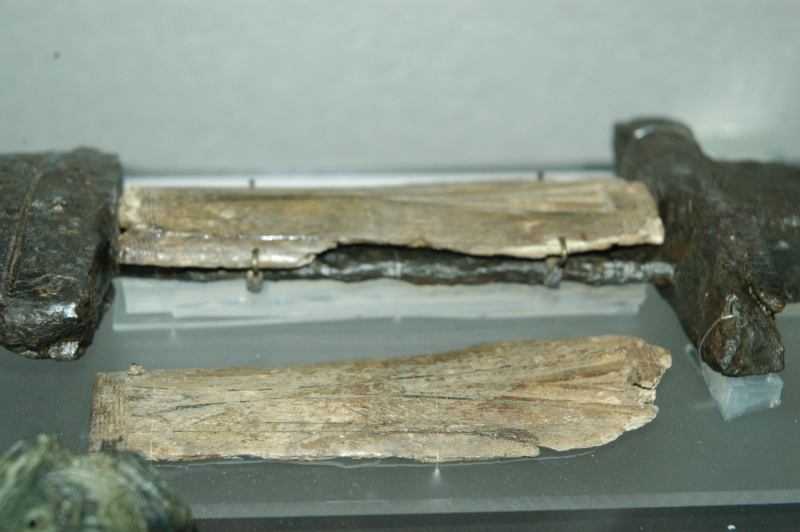
This is a two parts grip supposedly made of engraved reindeer antler. The tag explained that it shows the influence of Lappish (or whatever they were named at the time) artwork on viking artefacts. And it is actually close to modern "antler knives" of Lappish people.

Hi Gavin,
You replied saying, "One of the striking things about the sagas is how very little is explained. The teller very much assumes that the listener is familiar with everything he mentions."
Well, all I can say is that that was incredibly inconsiderate of them! :lol: I can see the sense in what you're saying from a couple of angles. I wouldn't spend a whole lot of time describing how to drive a car or use a cell phone if I was writing about something in present time. For the saga "composers", I suppose describing a weapon exhaustively would be akin to going into great detail about a oar; it was just a tool for a specific job. The sagas were oral history before they were written down and meant to be recited or sung as I understand it, so it's understandable that they would be "pruned down" to what was considered important.
Thanks,
Ken Speed
You replied saying, "One of the striking things about the sagas is how very little is explained. The teller very much assumes that the listener is familiar with everything he mentions."
Well, all I can say is that that was incredibly inconsiderate of them! :lol: I can see the sense in what you're saying from a couple of angles. I wouldn't spend a whole lot of time describing how to drive a car or use a cell phone if I was writing about something in present time. For the saga "composers", I suppose describing a weapon exhaustively would be akin to going into great detail about a oar; it was just a tool for a specific job. The sagas were oral history before they were written down and meant to be recited or sung as I understand it, so it's understandable that they would be "pruned down" to what was considered important.
Thanks,
Ken Speed
Chad & Richard,
Thank you both,
Richard said,There are a few original grips mentioned in "The Sword in Anglo-Saxon England"
Seems quite a few had wood cores covered with silver or bronze or even gold. In fact, quite a lot of the earlier examples appear to have had either metal grips, or metal covered grips."
Chad also mentioned metal grips. I have to admit I'm a bit surprised inasmuch as I wouldn't choose a metal grip for much of anything. I suppose if they typically wore a glove when using a sword as I read here a while ago a metal grip would be OK.
"The odd one was found with a horn grip,and ivory is mentioned in tha sagas as being one of the best grips ."
YES! That's the kind of information I hoped to find out. I suppose walrus ivory is more likely than elephant ivory considering the when and where of it all.
"The sword from Gillin-West, in Yorkshire is Anglo-Saxon mid 9th century, and it has thick silver 'washers' on the grip, and must have had slices of organic matter between these as spacers., (Maybe horn?)"
I'll see if I can find something on the web about that one. I can picture it as a migration era "stacked grip" or as a grip with scales running in the same direction as the tang with decorative washers like some hunting knife hilts and I don't know which one is correct.
"Interesting subject!"
Well thanks, I think it is an interesting question. We see replicas of these swords from practically every manufacturer or custom maker with the more or less ubiquitous leather wrapped grip and have no idea (speaking for myself) if this is even remotely historically accurate. J. T. Paalikko has a couple of Viking swords on his website that look convincingly authentic to me. One has a pommel and hilt of crudely forged iron and a simple wooden handle that makes sense visually, going back to the sword as tool idea and then there is another with blued furniture and an ivory grip that is stunningly beautiful although I imagine silver or gold plate would be more realistic than the blued finish. Could the smiths of the time color case harden steel I wonder? I guess the beauty and the curse of this whole thing is questions get answered and lead almost inevitably to more questions!
Regards,
Ken Speed
Thank you both,
Richard said,There are a few original grips mentioned in "The Sword in Anglo-Saxon England"
Seems quite a few had wood cores covered with silver or bronze or even gold. In fact, quite a lot of the earlier examples appear to have had either metal grips, or metal covered grips."
Chad also mentioned metal grips. I have to admit I'm a bit surprised inasmuch as I wouldn't choose a metal grip for much of anything. I suppose if they typically wore a glove when using a sword as I read here a while ago a metal grip would be OK.
"The odd one was found with a horn grip,and ivory is mentioned in tha sagas as being one of the best grips ."
YES! That's the kind of information I hoped to find out. I suppose walrus ivory is more likely than elephant ivory considering the when and where of it all.
"The sword from Gillin-West, in Yorkshire is Anglo-Saxon mid 9th century, and it has thick silver 'washers' on the grip, and must have had slices of organic matter between these as spacers., (Maybe horn?)"
I'll see if I can find something on the web about that one. I can picture it as a migration era "stacked grip" or as a grip with scales running in the same direction as the tang with decorative washers like some hunting knife hilts and I don't know which one is correct.
"Interesting subject!"
Well thanks, I think it is an interesting question. We see replicas of these swords from practically every manufacturer or custom maker with the more or less ubiquitous leather wrapped grip and have no idea (speaking for myself) if this is even remotely historically accurate. J. T. Paalikko has a couple of Viking swords on his website that look convincingly authentic to me. One has a pommel and hilt of crudely forged iron and a simple wooden handle that makes sense visually, going back to the sword as tool idea and then there is another with blued furniture and an ivory grip that is stunningly beautiful although I imagine silver or gold plate would be more realistic than the blued finish. Could the smiths of the time color case harden steel I wonder? I guess the beauty and the curse of this whole thing is questions get answered and lead almost inevitably to more questions!
Regards,
Ken Speed
Jean,
Thank you very much for the photo and the information. This is exactly the kind of information I was looking for.
Regards,
Ken Speed
Thank you very much for the photo and the information. This is exactly the kind of information I was looking for.
Regards,
Ken Speed
| Ken Speed wrote: |
| My question: Are there NO surviving grips from Viking age swords? ...
Ken Speed |
Hey Ken...
Here are some pics I have archived... What I know about them is in the file name... Just hold the cursor over the image to see the file name.
This first set are sword finds with surviving metal grips...
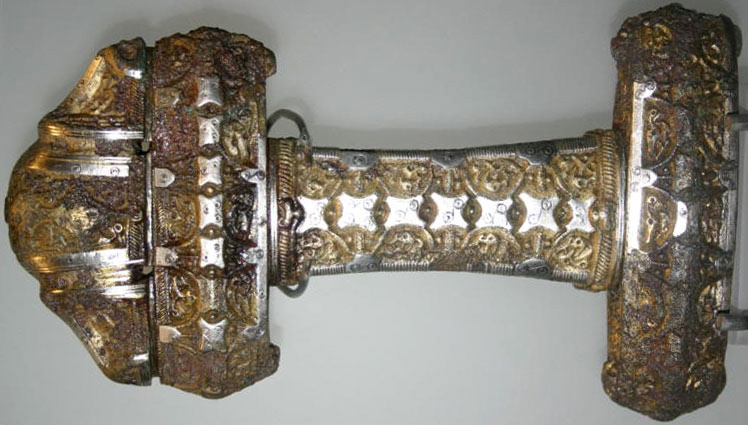
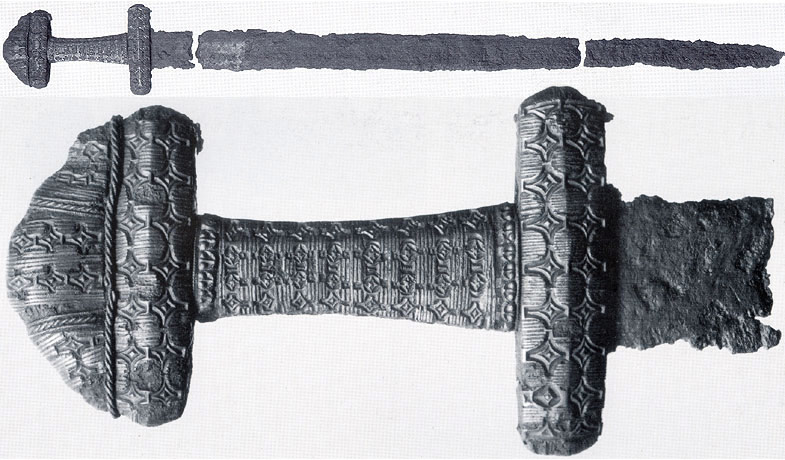
National Museum, Copenhagen
From "Swords of the Viking Age" by Ian Peirce
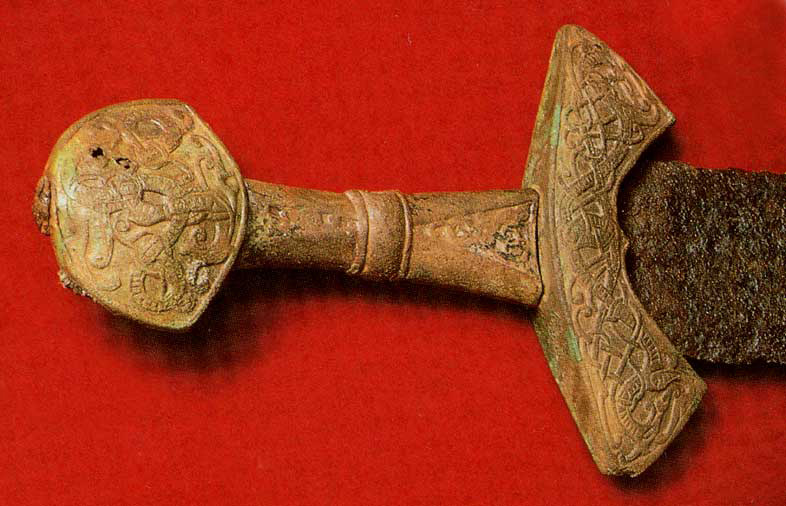
From "VIKINGS: North Atlantic Saga" ed. William Fitzhugh and Elisabeth Ward
Last edited by Kirk Lee Spencer on Thu 24 Apr, 2008 9:02 am; edited 1 time in total
Here are a couple of finds with wire wrap grips around a wooden core...
 Attachment: 99.87 KB
Attachment: 99.87 KB
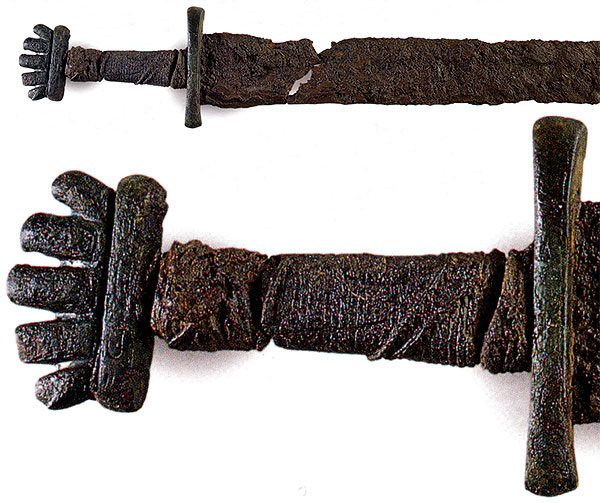
From "VIKINGS: North Atlantic Saga" ed. William Fitzhugh and Elisabeth Ward
 Attachment: 94.23 KB
Attachment: 94.23 KB
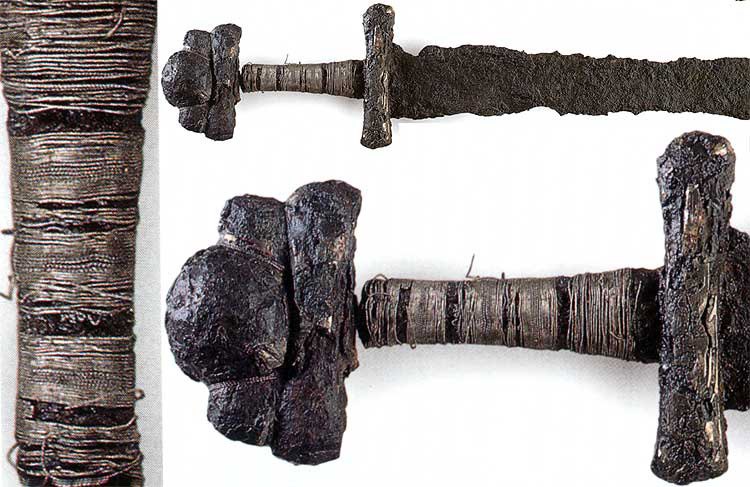
From "VIKINGS: North Atlantic Saga" ed. William Fitzhugh and Elisabeth Ward

From "VIKINGS: North Atlantic Saga" ed. William Fitzhugh and Elisabeth Ward

From "VIKINGS: North Atlantic Saga" ed. William Fitzhugh and Elisabeth Ward
Last edited by Kirk Lee Spencer on Thu 24 Apr, 2008 9:05 am; edited 1 time in total
Here are a few with furrels and spacers that suggest the grip shape...
 Attachment: 96.45 KB
Attachment: 96.45 KB
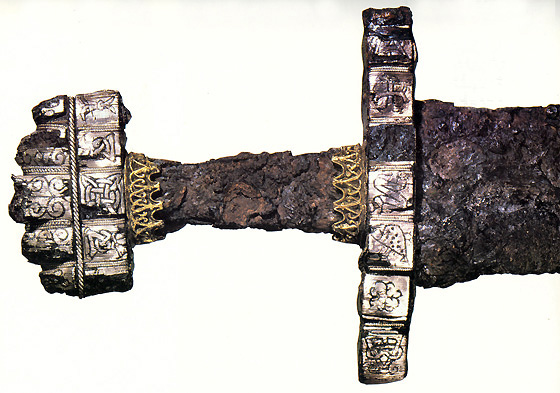
 Attachment: 96.93 KB
Attachment: 96.93 KB

From "VIKINGS:The Battle at the End of Time" by Tony Allan
 Attachment: 73.59 KB
Attachment: 73.59 KB
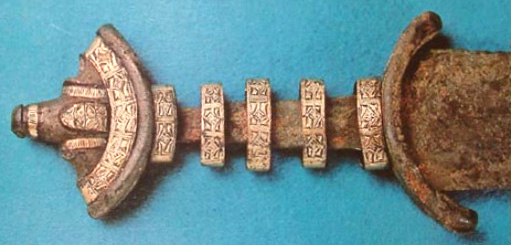
 Attachment: 97.49 KB
Attachment: 97.49 KB
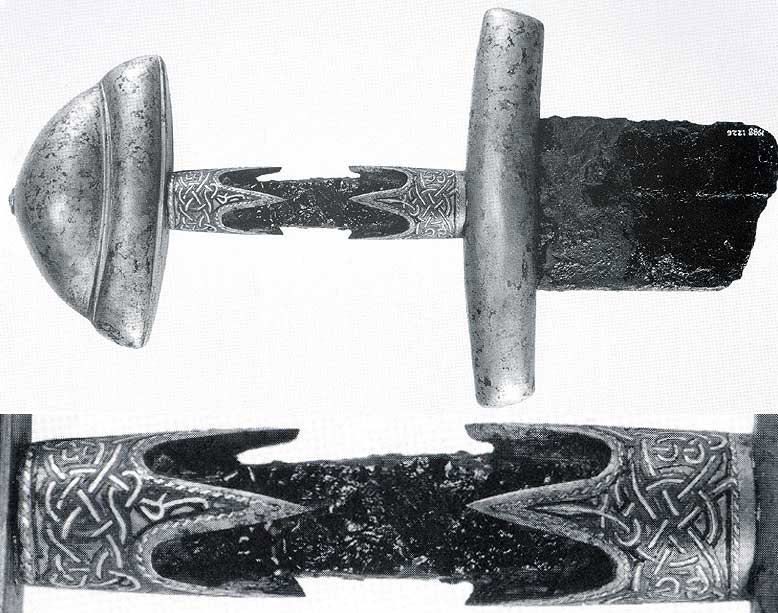
National Museum of Ireland, Dublin
From "Swords of the Viking Age" by Ian Peirce


From "VIKINGS:The Battle at the End of Time" by Tony Allan


National Museum of Ireland, Dublin
From "Swords of the Viking Age" by Ian Peirce
Last edited by Kirk Lee Spencer on Thu 24 Apr, 2008 9:07 am; edited 1 time in total
Here are a few finds with organic grip remains in various stages of preservation. One is antler (the one Jean posted earlier), one appears to be horn (the River Scheldt find), and there is even one (the type H with wire enlay) that may be leather...
Hope this helps...
take care
ks
 Attachment: 99.33 KB
Attachment: 99.33 KB

Universitetets Oldsaksamling, Oslo Norway
From "Swords of the Viking Age" by Ian Peirce
 Attachment: 99.57 KB
Attachment: 99.57 KB
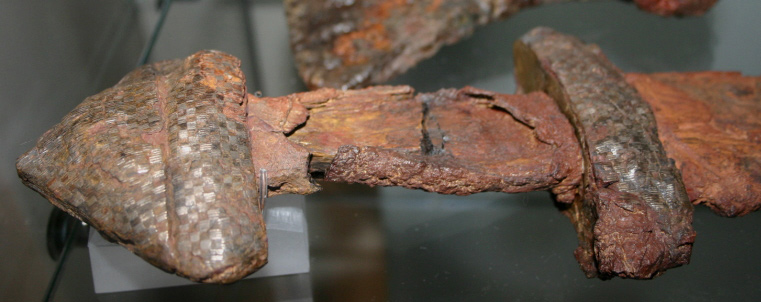
National Museum of Antiquities, Edinburgh
Photo by Thomas MacDonald
 Attachment: 99.02 KB
Attachment: 99.02 KB
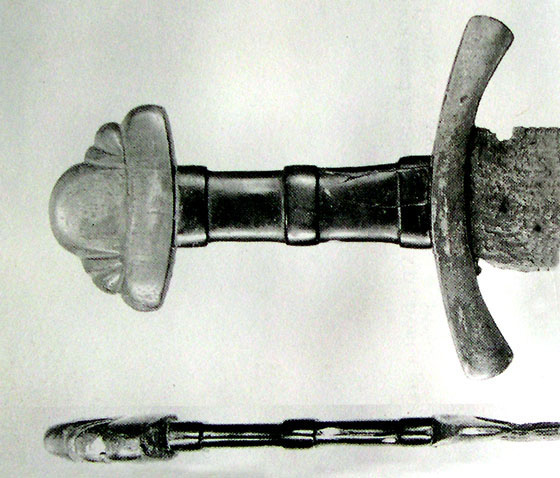
From "The Archeology of Weapons" by Ewart Oakeshotte
 Attachment: 50.63 KB
Attachment: 50.63 KB
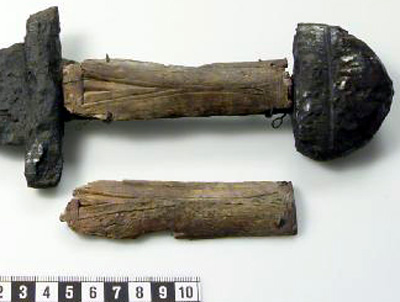
Historiska Museet
Hope this helps...
take care
ks

Universitetets Oldsaksamling, Oslo Norway
From "Swords of the Viking Age" by Ian Peirce

National Museum of Antiquities, Edinburgh
Photo by Thomas MacDonald

From "The Archeology of Weapons" by Ewart Oakeshotte

Historiska Museet
Last edited by Kirk Lee Spencer on Thu 24 Apr, 2008 9:13 am; edited 1 time in total
Ken,
If you punch in "Gilling-Wast sword" a picture should come up.
The grip was stacked, like the old leather handled sheath-knife.
Yes, walrus ivory was mentioned and was even used as a guard and pommel.
Just looking quickly at the above mentiond book Hilda says;
"..............Well known grip from Cumberland in Brit. museum....Grip and guard of horn, the grip indented to fit fingers.......broad boat-shaped-pommel....decoration of gold filigree....(of pos. later date) 7th C. in style.
(P.58.)
...2 swords from Petersfinger...wood covering for tang, made in 3 parts.....mid part had grain running parrelell to tang. upper and lower wood transverse to tang....Bronze guard and pommel at ends...(Sort of my abbraviated version af actual script!)
"....Rich gold adorned swords, (mid 5th to6th C....grips enclosed in precious metal..
..Hilt of King Childeric's sword of this type....
...grips of gold plating..
....Metal grips became fashionable in 6th C. Scandinavia......some fine examples may be seen in Behmer.
...Grips with metal rings a t each end...hold covering in place, as well as onamentation....
...2 hilts from Giton..(A.-saxon)& Faversham, & 1 fromCrundale down, (Brit. museum.). had..2 gold rings decorated with interlacing...
(P 59)
Must go, will look more later, but i think wood grip would have to have bands at both ends of grip, to stop wood splitting with the shock of use.
R.
If you punch in "Gilling-Wast sword" a picture should come up.
The grip was stacked, like the old leather handled sheath-knife.
Yes, walrus ivory was mentioned and was even used as a guard and pommel.
Just looking quickly at the above mentiond book Hilda says;
"..............Well known grip from Cumberland in Brit. museum....Grip and guard of horn, the grip indented to fit fingers.......broad boat-shaped-pommel....decoration of gold filigree....(of pos. later date) 7th C. in style.
(P.58.)
...2 swords from Petersfinger...wood covering for tang, made in 3 parts.....mid part had grain running parrelell to tang. upper and lower wood transverse to tang....Bronze guard and pommel at ends...(Sort of my abbraviated version af actual script!)
"....Rich gold adorned swords, (mid 5th to6th C....grips enclosed in precious metal..
..Hilt of King Childeric's sword of this type....
...grips of gold plating..
....Metal grips became fashionable in 6th C. Scandinavia......some fine examples may be seen in Behmer.
...Grips with metal rings a t each end...hold covering in place, as well as onamentation....
...2 hilts from Giton..(A.-saxon)& Faversham, & 1 fromCrundale down, (Brit. museum.). had..2 gold rings decorated with interlacing...
(P 59)
Must go, will look more later, but i think wood grip would have to have bands at both ends of grip, to stop wood splitting with the shock of use.
R.
Kirk,
You are the picture MAN!! It's like you have a picture of everything one could ask.
Bravo,
Jeremy
You are the picture MAN!! It's like you have a picture of everything one could ask.
Bravo,
Jeremy
| Jeremy V. Krause wrote: |
| Kirk,
You are the picture MAN!! It's like you have a picture of everything one could ask. Bravo, Jeremy |
He does actually, especially if you are asking for stuff prior to the middle ages... but he's working on that. :)
Richard,
OK, I know what the Gilling West sword looks like now, thanks. Naturally, as soon as I followed your instructions I realized that it was one of the sword pictures that Kirk posted.
Thanks again
Ken
OK, I know what the Gilling West sword looks like now, thanks. Naturally, as soon as I followed your instructions I realized that it was one of the sword pictures that Kirk posted.
Thanks again
Ken
Kirk,
Thank you for the wonderful pictures. Some really interesting sword hilts with amazing workmanship.
Ken
Thank you for the wonderful pictures. Some really interesting sword hilts with amazing workmanship.
Ken
Ken,
When I wrote my last post, kirk's wonderful posts hadn't showed when I started, but appeared afterwards.
(i'm slow at typing!.....)
Kirk,
Outstanding pictures! Many of them I have not seen before.
thank you for posting them.
When I wrote my last post, kirk's wonderful posts hadn't showed when I started, but appeared afterwards.
(i'm slow at typing!.....)
Kirk,
Outstanding pictures! Many of them I have not seen before.
thank you for posting them.
You can also deduct what they did or did not use from the naked tang.. is there drill holes corresponding to a riveted sandwich style? Is the tang shaped or larger then swords of equivalent size? I'm sure they analyze the rot & dust under the hilt of grave sites and sometimes extrapolate what materials the hilt was constructed of.
I'm sure guys like oakshott(do I have that right?) probably did some hands on reverse engineering based on written accounts & the sagas along with a handful of w.a.g's(wild ass guesses).
I'd bet dollars to doughnuts that the sword with the bone disks originally had leather/rawhide disk between them......Plus I'm sure they looked at early norman swords and threw in a few more wags.
I'm sure guys like oakshott(do I have that right?) probably did some hands on reverse engineering based on written accounts & the sagas along with a handful of w.a.g's(wild ass guesses).
I'd bet dollars to doughnuts that the sword with the bone disks originally had leather/rawhide disk between them......Plus I'm sure they looked at early norman swords and threw in a few more wags.
All,
What a wealth of information! I really appreciate it.
I find the two swords which bracket the Gilling West sword in the pictures especially interesting. While I wouldn't choose to have a thin round handle like both of them do I think the metal work on both is very striking. The top one has what appears to be the Gripping Beast type of decoration common to the Viking age but I can't get enough of a sense of it to tell what style of decoration (and thereby what historical period) it is. The one beneath the Gilling West sword seems to have a Celtic or very Celtic inspired pattern on the ferrules.
I have a feeling I may be talking to my friendly librarian about these and see if I can find some of those books that were mentioned in our library system. I suspect these particular swords are Vendel period because they are so beautifully decorated.
Ken Speed
What a wealth of information! I really appreciate it.
I find the two swords which bracket the Gilling West sword in the pictures especially interesting. While I wouldn't choose to have a thin round handle like both of them do I think the metal work on both is very striking. The top one has what appears to be the Gripping Beast type of decoration common to the Viking age but I can't get enough of a sense of it to tell what style of decoration (and thereby what historical period) it is. The one beneath the Gilling West sword seems to have a Celtic or very Celtic inspired pattern on the ferrules.
I have a feeling I may be talking to my friendly librarian about these and see if I can find some of those books that were mentioned in our library system. I suspect these particular swords are Vendel period because they are so beautifully decorated.
Ken Speed
Page 1 of 3
You cannot post new topics in this forumYou cannot reply to topics in this forum
You cannot edit your posts in this forum
You cannot delete your posts in this forum
You cannot vote in polls in this forum
You cannot attach files in this forum
You can download files in this forum
All contents © Copyright 2003-2006 myArmoury.com — All rights reserved
Discussion forums powered by phpBB © The phpBB Group
Switch to the Full-featured Version of the forum
Discussion forums powered by phpBB © The phpBB Group
Switch to the Full-featured Version of the forum